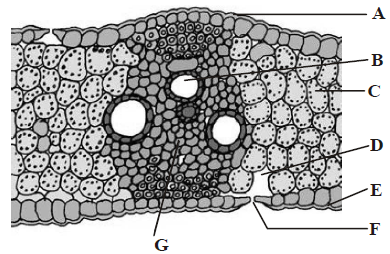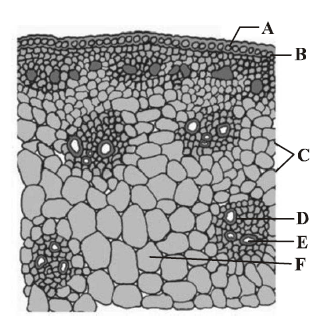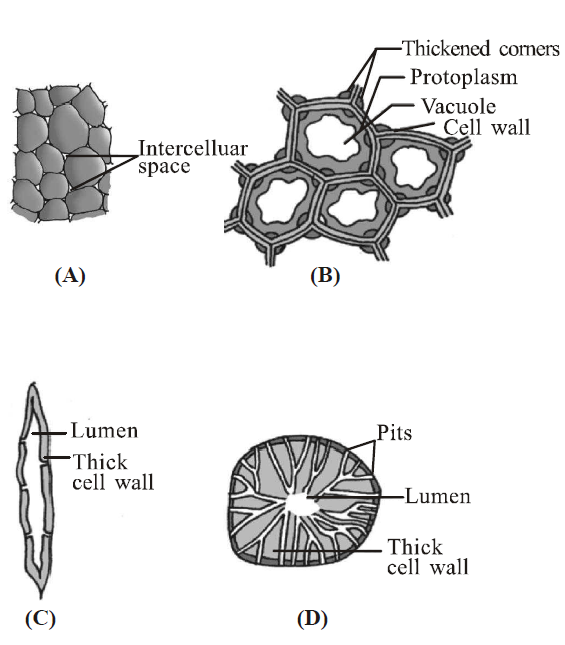The apical meristem of the root is present
in all the roots.
only in radicals.
only in tap roots.
only in adventitious roots.
Correct Answer :
A. in all the roots.
The apical meristem, or growing tip, is a completely undifferentiated meristematic tissue found in the buds and growing tips of roots in plants. Its main function is to begin growth of new cells in young seedlings at the tips of roots and shoots (forming buds, among other things). The apical meristem of the root is present in all of the roots.
Related Questions
T.S. of monocot leaf is given below, certain parts have been marked by alphabets (A G). Which one is the option showing there correct labelling?

A Adaxial epidermis, B Xylem, C Mesophyll, D Sub-stomatal cavity, E Abaxial epidermis, F Stoma, G Phloem
A Adaxial epidermis, B Abaxial epidermis, C Xylem, D Sub-stomatal cavity, E Stoma, F Mesophyll, G Phloem
A Adaxial epidermis, B Phloem, C Mesophyll, D Sub-stomatal cavity, E Abaxial epidermis, F Xylem, G Stoma
A Adaxial epidermis, B Xylem, C Stoma, D Substomatal cavity, E Abaxial epidermis, F Phloem, G Mesophyll
The given figure shows T.S. of monocot stem. Identify the correct labelling of A to F marked in the given figure.

A Epidermis, B Hypodermis, C Vascular bundles, D Phloem, E Xylem, F Ground tissue
A Cuticle, B Epidermis, C Sclerenchymatous sheath, D Sclerenchymatous hypodermis, E Parenchymatous sheath, F Phloem
A Cuticle, B Epidermis, C Sclerenchymatous hypodermis, D Sclerenchymatous sheath, E Parenchymatous sheath, F Phloem
A Cuticle, B Epidermis, C Sclerenchymatous hypodermis, D Sclerenchymatous sheath, E Parenchymatous sheath, F Protoxylem
Tissue(s) present in an annual ring is/are
secondary xylem and phloem.
primary xylem and phloem.
secondary xylem only.
primary phloem and secondary xylem.
The given diagrams show stomatal apparatus in dicots and monocots. Which one is correct option for A, B and C?

A Epidermal cells; B Subsidiary cells; C chloroplast
A Guard cells; B Subsidiary cells; C Stomatal pore
A Guard cells; B Epidermal cells; C Guard cells
A Epidermal cells; B Subsidiary cells; C Guard cells
The apical meristem of the root is present
in all the roots.
only in radicals.
only in tap roots.
only in adventitious roots.
Which type of plant tissue is being described by the given statements?
- It consists of long, narrow cells with thick and lignified cell walls having a few or numerous pits.
- They are dead and without protoplasts.
- On the basis of variation in form, structure, origin and development, it may be either fibres or sclereids.
- It provides mechanical support to organs.
Parenchyma
Sclerenchyma
Collenchyma
Chlorenchyma
A tissue is a group of cells which are
similar in origin, but dissimilar in form and function.
dissimilar in origin, form and function.
dissimilar in origin, but similar in form and function.
similar in origin, form and function.
Which of the following is responsible for the formation of an embryonic shoot called axillary bud?
Lateral meristem
Apical meristem
Intercalary meristem
Both
Gymnosperms are also called soft wood spermatophytes because they lack
cambium
phloem fibres
thick-walled tracheids
xylem fibres
A student was given a tissue to observe under the microscope. He observes the tissue and concludes that the tissue is a type of simple plant tissue and provides mechanical support to young stem and petiole of leaf.
Identify the tissue.
Parenchyma
Collenchyma
Sclerenchyma
Xylem parenchyma
In the given columns, column I contain structures of female reproductive system and column II contain its feature. Select the correct match.
| Column-I | Column-II |
|---|---|
| A. Lateral meristem | (i) Fascicular vascular cambium, interfascicular cambium and cork cambium. |
| B. Apical meristem | (ii) Produces dermal tissue, ground tissues and vascular tissue. |
| C. Bast fibres | (iii) Generally absent in primary phloem but found in secondary phloem. |
| D. Sap wood | (iv) Involved in the conduction of water and minerals from the root to leaf. |
A - (i), B - (ii), C - (iii), D - (iv)
A - (iii), B - (i), C - (ii), D - (iv)
A - (i), B - (iv), C - (iii), D - (ii)
A - (ii), B - (iv), C - (iii), D - (i)
The length of different internodes in a culm of sugarcane is variable because of
size of leaf lamina at the node below each internode
intercalary meristem
shoot apical meristem
position of axillary buds
Match column-I with column-II and choose the correct option.
| Column -I | Column -II |
|---|---|
| A. Bulliform cells | I. Initiation of lateral roots |
| B. Pericycle | II. Root |
| C. Endarch xylem | III. Grasses |
| D. Exarch xylem | IV. Dicot leaf |
| E. Bundle sheath cells | V. Stem |
A III, B V, C IV, D I, E II
A II, B V, C I, D III, E IV
A II, B IV, C I, D III, E V
A III, B I, C V, D II, E IV
Match the elements of xylem given in column I with their character given in the column II and choose the correct option.
| Column-I | Column-II |
|---|---|
| A. Xylem vessels | I. Store food materials |
| B. Xylem tracheids | II. Obliterated lumen |
| C. Xylem fibres | III. Perforated plates |
| D. Xylem parenchyma | IV. Chisel-like ends |
A IV; B III; C II; D I
A III; B II; C I; D IV
A II; B I; C IV; D III
A III; B IV; C II; D I
As secondary growth proceeds, in a dicot stem, the thickness of
sapwood increases.
heartwood increase.
both sapwood and heartwood increases.
both sapwood and heartwood remains the same.
Cambium is considered as a lateral meristem because
it gives rise to lateral branches.
it causes increase in girth.
it increases height and diameter of a plant.
it adds bulk to a plant.
Xylem functions as a conducting tissue for water and minerals from _________to the ______and__________.
roots, stems, leaves
stems, roots, leaves
leaves, stems, roots
leaves, stems, leaves
Match the followings and choose the correct option
| Column-I | Column-II |
|---|---|
| A. Cuticle | I. Guard cells |
| B. Bulliform cells | II. Outer layer |
| C. Stomata | III. Waxy layer |
| D. Epidermis | IV. Empty colourless cell |
A III, B IV, C I, D II
A I, B II, C III, D IV
A III, B II, C IV, D I
A III, B II, C I, D IV
Which of the following pair of match is not correct?
Pith - Large and well developed in monocotyledonous root.
Root hairs - Helps in preventing water loss due to transpiration
Sieve tube elements - Its functions are controlled by the nucleus of companion cells.
Stomatal apparatus - Consists of stomatal aperture, guard cells and surrounding subsidiary cells
Bast fibres are made up of _____________cells.
sclerenchymatous
chlorenchymatous
parenchymatous
aerenchymatous
Match the names of the structures given in column-I with the functions given in column-II, choose the answer which gives the correct combination of the two columns :
| Column-I | Column-II |
|---|---|
| (Structure) | (Function) |
| A. Stomata | I. Protection of stem |
| B. Bark | II. Plant movement |
| C. Cambium | III. Secondary growth |
| D. Cuticle | IV. Transpiration |
| V. Prevent the loss of water | ... |
A V, B III, C I, D IV
A I, B IV, C V, D III
A II, B IV, C I, D III
A IV, B I, C III, D V
Match the terms given in column I with their funciton given in column II and choose the correct option.
| Column-I | Column-II |
|---|---|
| (Term) | (Functions) |
| A. Meristem | I. Photosynthesis, storage |
| B. Parenchyma | II. Mechanical support |
| C. Collenchyma | III. Actively dividing cells |
| D. Sclerenchyma | IV. Stomata |
| E. Epidermal tissue | V. Sclereids |
A I, B III, C V, D II, E IV
A III, B I, C II, D V, E IV
A II, B IV, C V, D I, E III
A V, B IV, C III, D II, E I
Which of the following statements are correct ?
- Xylem transports water and minerals.
- Gymnosperms lack sieve tubes and companion cells in phloem.
- The first formed primary xylem is called metaxylem.
- Phloem fibres (bast fibres) are made up of collenchymatous cells.
(i) and (iii)
(i) and (ii)
(iii) and (iv)
(i) and (iv)
In an experiment, a student cut a transverse section of young stem of a plant which he has taken from his school garden.
After observing it under the microscope how would he ascertain whether it is a monocot stem or a dicot stem?
With the help of bulliform cells.
With the help of casparian strips.
With the help of vascular bundles.
With the help of stomatal apparatus.
Cork cambium and vascular cambium are
the parts of secondary xylem and phloem.
the parts of pericycle.
lateral meristems.
apical meristems.
Read the following statements and answer the question.
- Cambium is very active and produces a large number of xylary elements having vessels with wider cavities.
- It is also called early wood.
- It is lighter in colour and has lower density.
Which type of wood is described by the above statements?
Sap wood
Heart wood
Spring wood
Autumn wood
Phellogen and phellem respectively denote
cork and cork cambium,
cork cambium and cork,
secondary cortex and cork,
cork and secondary cortex,
Identify the types of simple tissue indicated by A, B, C and D and their function.

A Parenchyma, Photosynthesis, Storage and Secretion.
B Sclerenchyma Scleriods; Transport food material
C Collenchyma; Provides mechanical support to organs.
D Sclerenchyma Fibres; Provide Mechanical support to the growing parts of the plant such as young stem and petiole of a leaf.
Which of the following are present in monocot root ?
conjoint, collateral, open polyarch vascular bundle.
exodermis, endarch, tetrarch closed vascular bundles.
suberized exodermis, casparian strip, passage cells, cambium.
suberized exodermis, polyarch xylem, pith.
In land plants, the guard cells differ from other epidermal cells in having
cytoskeleton.
mitochondria.
endoplasmic reticulum.
chloroplasts.
